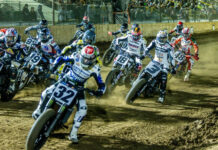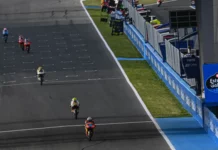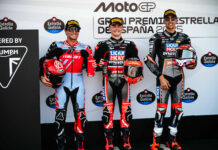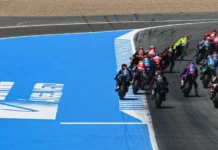Testing, Testing One of the primary reasons why Kawasaki’s racing efforts in World Superbike have taken such an upswing in recent times is an intense testing schedule, which takes place away from race weekends. The important role testing plays in going racing to win is difficult to underestimate, especially in a closely matched championship such as SBK, where six major manufacturers are vying to beat each other every time out. There are two main types of test for major teams like KRT. Off-season testing, when points are not up for grabs and thus any major changes to a bike or its set-up can be made before a final direction of development strategy is settled on. Then there are the mid-season tests, which either allow new parts or modified settings to be used and evaluated, with a more tactical viewpoint, before they are used in the heat of battle. We asked the KRT personnel most in the know about the role of testing in SBK racing for their opinions about how important extra track time is, at any stage of the season. Team Manager Guim Roda, understandably, sees things from an overall point of view, as he is the man responsible for all aspects of the squad when they get to the racetracks. “In winter-testing, from my side, there are three main points,” said Roda. “One is trying to create a clear space between the last race of last year and the first race of next season. You use it to recharge the batteries for next year. The next point is like when you go to school. If you do not study you cannot get a good result in the exam. Winter testing, even all testing, is like when you study, so you can get good results on a race weekend. It is difficult to develop new ideas during a race weekend. Also in the off season this is the time to develop, especially in a factory team, because this is when you can understand what development is coming and also you know the information you will send back to Japan.” Loris Baz’s Crew Chief Pere Riba has been part of the Kawasaki development programme for a long time, and understands the methodology very well. “Winter testing is about working with a factory in the background to improve the bike. It is important because during races it can be difficult to test depending on what new things come along. In the race weekend you have to get the maximum from the base you have to get a good result. When you change some big points, for example in the geometry side, you cannot get the best result in one day. You need more time, and sometimes you need different tracks to confirm 100% what you are doing. It is very easy to lose the line when you are developing a bike. If you try something new and it is a good thing on three tracks, then it is a good thing! Nowadays, it is more difficult in testing and also less difficult. Now you have many ways to modify the bikes, so if you know 100% what you want, you can go there. But this can also be a negative if you lose the direction.” As a former top level rider himself, Riba also understands the importance of keeping the rider’s ‘eye’ in. Viewing life at 300 kilometres per hour is not part of the normal human condition, so riders need regular exposure to more than 220 bhp and over 320 kilometres per hour to be at their best when the season starts, or a big gap between rounds is encountered. “The rider must be used to the sheer speed of the bike. Even if you test with a motocross bike or a supermotard, it just is not the same. The real test is on the Superbike.” Marcel Duinker, Crew Chief of Tom Sykes, is another who firmly believes a much more extensive testing programme has shown benefits from last year to 2012. “I think we have shown that testing is very important,” said Duinker. “It was the second year of the Ninja ZX-10R, but the previous year the development was not as extensive as this year, so after the final round in Portimão in 2011 we started from scratch. When everything is new you need to build on a solid base by testing. You can test many times but if you have the knowledge in house after a few tests then you are done and you must face your competitors first. You can test ten times but four is enough. You set-up your bike, go fast, and then suddenly think to yourself, “OK, what else?” Duinker continued, “When we were in Almeria in January of 2012 we said, “OK, what will we do now? Beat the lap record? OK let’s do it.” But after that you go out and meet your competitors in a race and after one race you know straight away what to work on next. You then know what is your biggest limitation. During the season you realise that we are short in this or that area of performance. This year the team gave us the opportunity to go out for testing when we found a limitation on the bike and this is one of the reasons why we are so close to the top now.” Ichiro Yoda, Racing Manager from KHI, is responsible for the project overall, with particular emphasis on engineering developments from the factory back in Japan. He explained that testing, both off-season and in the middle of the season, is simply vital when you have a non-stop cycle of development going on back at the headquarters. “After every race we have a clear target to improve for the next race,” said the experienced Yoda. “If we have a rush in the racing activity then we have no time to bring new parts. We have quite limited time on race weekends, 45 minutes free practice and then suddenly we go to qualifying to set a lap time. If we have testing opportunities away from races then we can evaluate things before we come to a race meeting. The final judgement of everything is at races. If we have a good result on the dyno, or on the Japanese test track, the final judgement must still come from these two riders, Tom and Loris.” Yoda also looks at the human element as important. Along with the need for regular testing there is also the need for rest and relaxation, now forced on everyone in any case by a testing ban through all of December to mid January. “Testing is very important, also to keep the physical condition and sharpness of riders. In the off-season you bring all new things to test. With the winter testing ban it can be a problem but also the riders have to ‘switch off’ sometimes and enjoy their lives. Also the mechanics and everyone else. Also myself! Even during the testing ban, back in Japan the development work never stops. When I go to KHI in Japan every day they are working until late at night. They work very hard. We pushed things forward a lot in the end of the year in 2012.” The final result of all that combined effort was coming to within half a point of the championship itself, proof positive that an integrated and extensive testing programme, done well, makes a real difference when it comes to raceday possibilities.
Kawasaki Talks About How Important Testing Is To Its World Superbike Program
Kawasaki Talks About How Important Testing Is To Its World Superbike Program
© 2012, Roadracing World Publishing, Inc.






